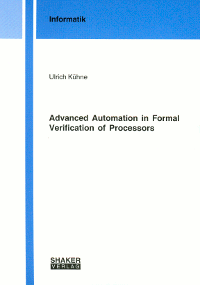Advanced Automation in Formal Verification of Processors
Autor: Ulrich Kühne
Verlag: Shaker Verlag
Format: Gebunden
Erscheinungsjahr: 2009
This book focuses on the functional verification of digital systems
with a special focus on processors, using formal techniques. With the
increasing size and complexity of digital systems, verification has
become a major bottleneck in the design flow. Furthermore, embedded
systems are used more and more in safety critical applications like
automotive or avionic control and in medical equipment.
While simulation based methods cannot exhaustively verify large
systems, formal verification offers a very high level of
confidence. But, up to today, formal methods are difficult to use in
practice, as they require deep knowledge of the verified design as
well as a high expertise in the applied techniques. Here, the
automation of these formal techniques is addressed in order to raise
the verification productivity while maintaining the high quality of
the results.
The contributions are twofold: in the first part of the book,
improvements for the traditional bottom-up verification flow for
digital systems are presented. The second part deals with an
innovative top-down verification flow for processors, where the
starting point is an abstract architecture description.
When facing the functional
verification of smaller digital systems, a bottom-up approach is
applied. Here,
Bounded Model Checking (BMC) is used in order to
prove the correctness of single hardware blocks before moving on to
the integration of these components on system level. Even for embedded
software, BMC can be used efficiently. For
arithmetics and memories, word level techniques are used to speed up
the automated proofs.
In this bottom-up flow, a
coverage check provides feedback to the user
and points him or her to those scenarios that have not been verified
yet. This provides a clear guideline for the verification, while
ensuring that the whole functionality of a design has been verified as
soon as the coverage check is passed.
On the way to full coverage, the user is supported in writing
properties by two supplementary techniques. A
property analysis
determines redundant assumptions in a property. In this way, properties
can be strengthened automatically in order to meet the coverage goals
more quickly. Based on this analysis, with
inverse property
checking, valid properties can be generated automatically, that
match a given proof goal or expected behavior. These generated
properties are then validated by the user wrt. the
specification.
Overall, the presented techniques offer an advanced user support in
order to speed up the formulation of concise properties that cover the
complete functionality of the design under verification.
When focusing on restricted classes of hardware designs, a
higher degree of automation can be achieved in a top-down approach. In
this book, this is demonstrated for the example of processors. The
functional verification of a processor consists in finding a mapping
between the
instruction set architecture (ISA) - the
programmer's view, given by the textual specification - and the
register transfer level (RTL) implementation. The main
difficulty in this process is caused by the various optimizations
found in modern processors.
In this book, a top-down verification approach for processors is
presented. It starts with an abstract architecture description that
can easily be derived from the ISA specification. This architectural
model is then mapped to the RTL implementation. For this step, the
user needs to implement a number of given mapping functions and
predicates. These functions reflect the concepts of a correct
implementation of a pipelined processor.
Based on the architecture description and the mapping information, a
property suite is generated automatically that is complete by
construction, i.e. the ISA of the processor is verified
exhaustively. It can be checked on the RTL design using the efficient
property checking tool OneSpin 360 MV. The method is
demonstrated on an industrial processor design from the automotive
domain. Using the new approach, the verification productivity could be
doubled compared to a manual verification.
Moreover, the use of architectural models in the formal verification
offers further possibilities for automation in the design flow. In the
book, it is shown how such models can be used both for the
verification as well as for the automatic generation of an
instruction set simulator (ISS). ISSs play an
important role for the early software development and testing. By
using a single source for verification and the ISS, a proven correct
simulator can be obtained as soon as the verification is completed. It
can easily be adapted if late changes in the design or the
specification occur.
Overall, the presented techniques allow for a more efficient formal
verification of processors. By reusing the architectural models, a
further gain in productivity can be achieved.
